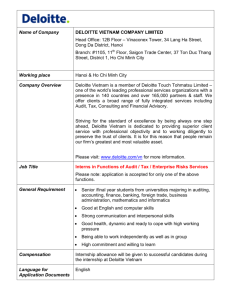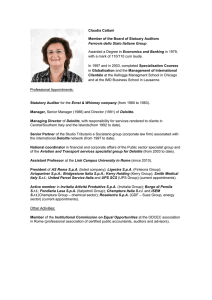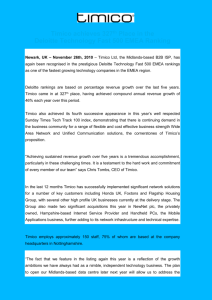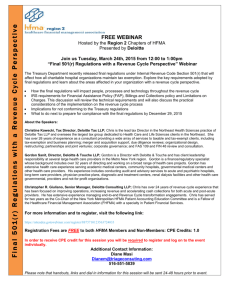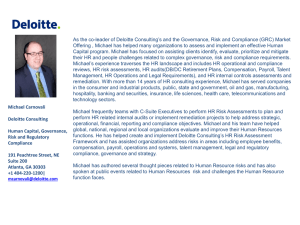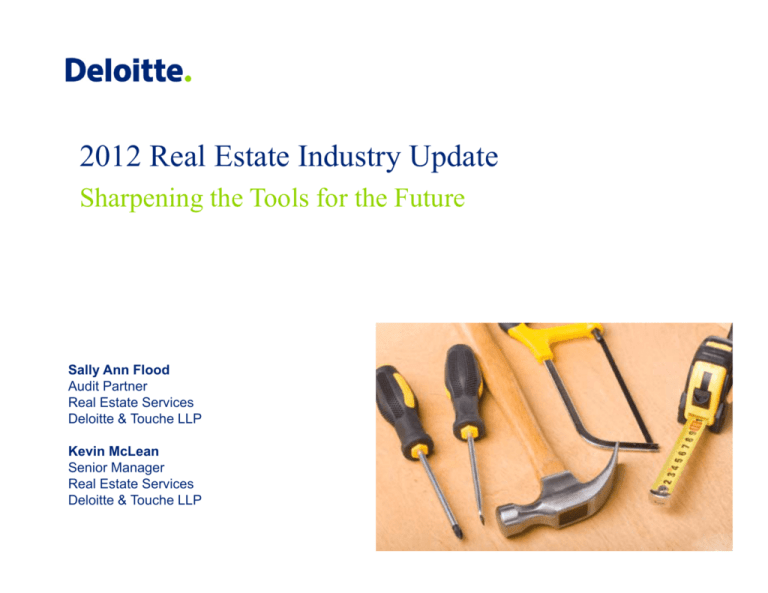
2012 Real Estate Industry Update
Sharpening the Tools for the Future
Sally Ann Flood
Audit Partner
Real Estate Services
Deloitte & Touche LLP
Kevin McLean
Senior Manager
Real Estate Services
Deloitte & Touche LLP
Copyright © 2012 Deloitte Development LLC. All rights reserved.
Agenda
Standards Setting
FASB Projects
FASB Done Deals
SEC Comments on Real Estate Companies
Copyright © 2012 Deloitte Development LLC. All rights reserved.
Disclaimer
• This presentation does not provide official Deloitte & Touche LLP
interpretive accounting guidance
• The views expressed are solely those of the presenter and are not
formal Deloitte & Touche LLP positions
• Check with a qualified advisor before taking any action
• See slides at the end for additional resources available on these topics
Copyright © 2012 Deloitte Development LLC. All rights reserved.
Standards Setting
Where are we at and where are we going?
Copyright © 2012 Deloitte Development LLC. All rights reserved.
Convergence Challenges
The FASB and the IASB have been working toward accounting convergence since
2002.
– This effort is at least partially working for revenue recognition and leases
– Sharp disagreements among the Boards in the areas of insurance,
impairment, investment companies projects and valuation of bank loans and
timeliness of their write-downs
Copyright © 2012 Deloitte Development LLC. All rights reserved.
Public Feedback on Incorporating IFRS
From comment letters and roundtable discussions
Consistent views
• Largely supportive of the
SEC’s approach and IFRS
as the single global
accounting standard
• Strong FASB role
• Retaining US GAAP
reference to ease
contractual and regulatory
burdens
• Establish criteria or
threshold for modifications
from IFRS
Divergent views
• Single date verses
staggered adoption
• Adoption timetable
• Retrospective or
prospective adoption of new
standards
• Option to early adopt
Concerns raised
• Inconsistent interpretation
and enforcement by
regulators/auditors
• IASB independence,
funding and due process
• Reluctance of IASB to issue
interpretative guidance
• Impact on specialized
industry guidance with no
IFRS equivalent
• Smaller registrants
concerned with resources
and cost
• Litigation risks should be
evaluated
Copyright © 2012 Deloitte Development LLC. All rights reserved.
Convergence Challenges
• On July 13, 2012, the SEC Staff released its final report where it considered all
possible ways to align IFRS and GAAP and highlighted challenges:
– Currently several areas in which the accounting approaches diverge, such as
impairment models for financial instruments, investment property, investment
companies
– Concerns about the comprehensiveness of IFRS, including lack of industry
guidance
– The significant expense that both large and small companies would incur in
any switch from GAAP to IFRS
Copyright © 2012 Deloitte Development LLC. All rights reserved.
Project Timeline: Joint projects
Expected date
Projects
Converged?
Leases
Revenue recognition
Financial instruments:
• Impairment
2012
2013
Partially
E
Yes
F
No
E
Partially
E
• Hedge accounting — General (IASB)
N/A
RD/F
• Hedge accounting — Macro (IASB)
N/A
ED
Insurance contracts
No
E
Investment companies
No
F
Partially
F
• Classification and measurement
Consolidation
E — Exposure Draft
F — Final Standard
Copyright © 2012 Deloitte Development LLC. All rights reserved.
RD — Review Draft
FASB — only projects
Expected date
2011
2012
H1
Projects
Financial Instruments: Liquidity & Interest Rate
Disclosures
E (June)
Liquidation Basis of Accounting
E (July)
2013
H2
Going Concern
E
Transfers and Servicing: Repurchase
Agreements
E
Investment property entities (IPE)
E (Oct)
O
Definition of a Nonpublic Entity
D (July)
Disclosure framework
D (July)
E — Exposure Draft
Final — Final Standard
Copyright © 2012 Deloitte Development LLC. All rights reserved.
D – Discussion Memo
O – On Hold
H1
Inactive Joint Projects
Projects
Reporting discontinued operations
Financial statement presentation
Financial instruments with characteristics of equity
Emissions trading schemes
Copyright © 2012 Deloitte Development LLC. All rights reserved.
Small GAAP vs. Big GAAP
Private Company Council
• In May 2012 the FAF (FASB’s parent foundation) decided to establish a
Private Company Council (PCC)
– The FAF trustees will appoint 9 to 12 members to the PCC
– Board members must have private company experience and will represent
various groups, including users, preparers, and auditors
• Responsibilities of the PCC:
– Advise the FASB on how private companies should treat current pending
projects
– Determine whether exceptions or modifications to existing U.S. GAAP would
benefit private company financial statement users
• The FASB still has the final say
– All exceptions and modifications proposed by the PCC would be subject to
FASB ratification
– This is similar to how the EITF functions
Copyright © 2012 Deloitte Development LLC. All rights reserved.
JOBS Act
Background
• April 5, 2012: The Jumpstart Our Business Startups Act (JOBS Act)
was signed into law
• To reduce the burden smaller companies face in obtaining capital, the
JOBS Act limits some regulatory requirements, including:
– Creating an exemption for “crowdfunding” transactions
– Increasing shareholder thresholds that trigger public company registration and
reporting from 500 to 2,000 shareholders
• The bill also established a new category of issuers called Emerging
Growth Companies (“EGC”)
Copyright © 2012 Deloitte Development LLC. All rights reserved.
What is an Emerging Growth Company?
• EGCs are entities with annual gross revenues of less than $1 billion
• An entity would remain an EGC until the earlier of:
– The year in which annual gross revenues exceed $1 billion
– The fifth anniversary of an effective registration statement
– The date an issuer becomes a large accelerated filer ($700 million in public
float)
Copyright © 2012 Deloitte Development LLC. All rights reserved.
Benefits of Being an EGC
• EGCs will:
– Only include two years of audited financial statements in a registration
statement
– Gain relief from the internal control audit requirements under Section 404(b) of
the Sarbanes-Oxley Act of 2002
– Be treated as private entities with respect to any new or revised accounting
standards issued after April 5, 2012
– Have fewer restrictions on pre-filing communications
– Be provided with additional safe harbors to allow more analyst research
coverage
– Be permitted to reduce disclosures on executive compensation
– Be permitted to have confidential reviews of draft IPO filings
Copyright © 2012 Deloitte Development LLC. All rights reserved.
Concerns Expressed
• The FAF (FASB’s parent foundation)
– Testified to the Senate that this would “raises serious issues about the
continued independence of the standard-setting process”
• New York Times editorial piece “They Have Very Short Memories”
published on March 11, 2012
– “[The bill] would undo essential investor protections, reduce market
transparency and distort the efficient allocation of capital”
– “…testimony, market analysis and academic research have shown that
regulation has not been an impediment to raising capital”
– “…[the bill] could expose unsophisticated investors to offerings that they
cannot properly evaluate”
Copyright © 2012 Deloitte Development LLC. All rights reserved.
FASB Projects Impacting the Real Estate
Industry
Copyright © 2012 Deloitte Development LLC. All rights reserved.
Revenue Recognition
Timeline and Recent Developments
Month/Year
Milestone
June 2010
Initial exposure draft issued
June 2011
Final decision by Boards to re-expose
Q4 2011
Issued revised exposure draft on 11/14/2011
with a 120 day comment period
Q4 2011 – Q1 2012
Perform outreach activities
Q1 2012 – Q4 2012
•
Evaluate feedback, perform public outreach,
and finalize redeliberations
First half 2013
Finalized revenue standard anticipated
• Effective date:
– Public Companies: No earlier than January 1, 2015
– Non-public companies: One year later than public companies (January 1, 2016)
– Full retrospective application may be required
Copyright © 2012 Deloitte Development LLC. All rights reserved.
Key Concepts in the Exposure Draft
Transfer of Control
Performance
Obligations
One Size
Fits
All
Copyright © 2012 Deloitte Development LLC. All rights reserved.
Question:
Can a “one size fits
all model” work for
everyone?
Core Principle and Steps in the Model
• Core principle:
– Recognize revenue to depict the transfer of promised goods or services to
customers in an amount that reflects the consideration the entity expects to
be entitled in exchange for those goods or services
Step 1
Step 2
Step 3
Step 4
Step 5
Identify the contract with a customer
Identify the separate performance obligations in the contract
Determine the transaction price
Allocate the transaction price to the separate performance
obligations
Recognize revenue when (or as) the entity satisfies a
performance obligation
Copyright © 2012 Deloitte Development LLC. All rights reserved.
Potential Effects on Real Estate
Impact areas
• NOT apply to lease contracts, financial instruments, guarantees, or most
insurance contracts
• WILL apply to the following:
– Sales of real estate,
– Development of real estate,
– Management services,
– Asset management fees,
– Custodial or maintenance services
• When does revenue recognition guidance apply?
– Does this just apply to “sales”, or
– Does it apply to all deconsolidation events of in-substance real estate?
• Non-controlling interest in real estate
• Loss of control of a property to a lender (EITF 10-E)
Copyright © 2012 Deloitte Development LLC. All rights reserved.
Potential Effects on Real Estate
Elimination of bright-line tests
• Can we look to the old (industry specific) rules to supplement the new
rules?
– The board would not expect…accounting firms to be developing guidance
based on old…GAAP to supplement the new [revenue recognition] standard.
Leslie Seidman, FASB Chairman
• Prescriptive guidance provided by ASC 605 (Construction) and ASC 36020 (Sales of Real Estate) will be lost:
–
–
–
–
Buyer’s financial commitment
Collectability of transaction price
Continuing involvement by seller
Sales to limited partnerships/joint ventures
Copyright © 2012 Deloitte Development LLC. All rights reserved.
- Guarantee buyer return
- Partial sales
- Condominium sales
- Sale-leaseback transactions
Potential Effects on Real Estate
Elimination of bright-line tests
• Has the buyer made an adequate initial and continuing investment?
• Are you reasonably assured that the buyer is committed and will pay?
• Use of judgment when evaluating continuing involvement
– Identify performance obligations (liabilities): property management services,
commitments to support operations, development commitments
– Allocate revenue to each of the performance obligations; recognize revenue
when performance obligations are completed
Copyright © 2012 Deloitte Development LLC. All rights reserved.
Potential Effects on Real Estate
Use of judgment and reduced emphasis on collectability
How will this change conclusions related to real estate transactions?
• Will likely result in more transactions qualifying as sales of real estate with
gains being accelerated
– Transactions that include contingent proceeds (often considered continuing
involvement) may qualify for sales recognition
Example – participation in future profits from a sold property if reasonably
assured to be entitled
•
Collectability would affect the amount of gain or loss, not recognition, of
revenue
– Boards still analyzing approaches to accounting for buyer credit risk
Copyright © 2012 Deloitte Development LLC. All rights reserved.
Potential Effects on Real Estate
Repurchase options
• If the seller has an unconditional obligation or right to repurchase:
– No sale can be recognized
• Control of the asset has not been transferred to the buyer
• Accounted for as a financing or leasing transaction
– You cannot consider probability as part of this assessment
– Can you recognize a sale when the seller only has a “conditional”
repurchase option?
Copyright © 2012 Deloitte Development LLC. All rights reserved.
Potential Effects on Real Estate
Impact on engineering and construction sector
• Existing US GAAP:
– The entire contract is typically the unit of account
• Exposure draft (November 2011):
– At a minimum, separate performance obligations when the prices of the related
goods and services are independent
– Further analysis is needed to determine whether separation into additional
accounting units (performance obligations) is required
• Potential implications for the construction industry:
– Entities could no longer assume that an entire construction contract is the unit of
account
– Multiple accounting units could be required
• Design and production elements with different price structures could be
required to be separated for accounting purposes
Copyright © 2012 Deloitte Development LLC. All rights reserved.
Identifying separate performance obligations
NEW!
Is the entity
integrating
a bundle of
highly
interrelated
goods or
services?
No
Yes
Treat as a single
performance obligation
and recognize revenue
when control transfers
Do the
promised
goods or
services
transfer at
the same
time?
Yes
Account for distinct
performance obligation(s)
separately
No
Does the
good or
service have
a distinct
function?
No
Yes
Combine performance
obligations until two or
more performance
obligations are distinct
• A good or service is “distinct” if it either:
– Is regularly sold separately by the entity , or
– Can be used on its own or together with resources that are readily available to the
customer
Copyright © 2012 Deloitte Development LLC. All rights reserved.
Financial Instruments
Project Update
Topic
FASB
IASB
Classification and
Measurement
•
•
•
Redeliberations substantially
completed
FASB is revisiting certain
tentative decisions
IASB issued IFRS 9, Financial
Instruments, in November 2009
(revised in October 2010)
IFRS 9 is effective from January
1, 2015
•
The boards jointly deliberated key elements of their respective
models, which are now more closely converged.
Impairment
Both Boards were evaluating a jointly developed new expected-loss
impairment model (“three bucket approach”). FASB is now working
on an alternative model based on recent comments.
Hedge
Accounting
•
Redeliberations have not
yet begun
•
Expects to issue a separate
discussion paper on macro
hedge accounting in 2013
Liquidity &
Interest Rate Risk
Disclosures
•
Issued ED June 27, 2012 and
comment period ended
September 25, 2012
•
•
IFRS 7 issued 2005
The IASB does not have a
current project to amend this
standard
Copyright © 2012 Deloitte Development LLC. All rights reserved.
Classification and Measurement
Debt-Instrument Financial Assets (e.g., debt security, loan, receivable)
New (tentative) Approach
What’s Changed?
Amortized cost —
• “Intent” no longer
1) meet cash flow characteristics assessment, and
2) are managed within a business model whose objective relevant (e.g., to trade or
to hold until maturity)
is to hold the assets to collect contractual cash flows.
• For certain assets, the
classification and
FV-OCI —
measurement attributes
1) meet cash flow characteristics assessment, and
2) are managed within a business model whose objective will change.
is to both hold the assets to collect contractual cash • The ability to account for
flows and sell assets.
loans held for sale at the
lower of cost or fair value
FV-NI —
would be eliminated, all
1) fail cash flow characteristics assessment, and
at FV-NI
2) those that pass the assessment but are not held within
a business model consistent with amortized cost or
FV-OCI. (e.g., equity instruments, derivatives)
Cash flow characteristics assessment — A financial asset would be eligible for a
measurement category other than FV-NI if the contractual terms give rise on specified
dates to cash flows that are solely payments of principal and interest on the principal
amount outstanding.
Copyright © 2012 Deloitte Development LLC. All rights reserved.
Classification and Measurement
Investments in Equity Securities
New (tentative) Approach
• Marketable and nonmarketable equity
securities —at FV-NI
Practicability exception —
Nonmarketable equity securities at cost
less impairment plus or minus changes in
observable prices.
What’s Changed?
• For marketable equity
securities, no AFS category
with changes in FV recorded in
OCI.
• The FVO for equity method
investments replaced by an FVNI requirement for equity
• Equity method — Investors that have
investments that are held for
significant influence apply the equity method
sale.
of accounting unless the investment is
held for sale, in which case FV-NI.
• Entities would no longer be
required to determine whether
• Single-step impairment approach to
impairment losses are other
nonmarketable equity securities and equity
than temporary.
method investments.
Copyright © 2012 Deloitte Development LLC. All rights reserved.
Impairment Model Convergence Challenges
“This is deeply embarrassing…. This whole thing is going to unravel”
Hans Hoogervorst, Chairman, IASB
Copyright © 2012 Deloitte Development LLC. All rights reserved.
Impairment of Financial Instruments
FASB’s alternative – Current expected credit loss (CECL) model
• Current estimate of future contractual cash flows that management does
not expect to collect
• The measurement of expected credit losses would (1) be an expected
value (i.e., a probability-weighted average of at least two possible
outcomes) and not the most likely outcome and (2) incorporate the time
value of money
• Contemplates “all supportable internally and externally available
information…, including past events, current conditions, and reasonable
and supportable forecasts”
• Includes modified financial instruments (loans modified under TDR)
• As of each reporting date, an entity would recognize a credit impairment
allowance equal to its current estimate of expected credit losses and
recognize changes through earnings
Copyright © 2012 Deloitte Development LLC. All rights reserved.
Leases
Lease Project Timeline
Original Exposure Draft (ED)
Comment period ended
December 2010
Issued in August 2010
Over 750 letters received
Redeliberations
Revised ED expected 1st Quarter of 2013
Final Standard
Expected to be issued 2013
Effective Date
Expected to be no sooner than 2016
Copyright © 2012 Deloitte Development LLC. All rights reserved.
Lessee accounting
“Right-of-use” (ROU) model
ROU asset
Initial
measurement PV of lease payments + lessee’s initial direct costs
Lease liability
• PV of lease payments
• Discount rate: Rate lessor is charging lessee if readily available; otherwise,
lessee’s incremental borrowing rate
ROU asset
Subsequent
measurement • Amortized cost: Method of amortization depends on nature of underlying asset
(see slides that follow)
• Impairment: Refer to existing standards (ASC 360, IAS 36)
Lease liability
• Amortized cost: effective interest method
Copyright © 2012 Deloitte Development LLC. All rights reserved.
Lessee accounting
ROU model’s income statement effect
Copyright © 2012 Deloitte Development LLC. All rights reserved.
Constituents’
concern about
income statement
effect being
inconsistent with
lease economics
Lessee Accounting
Expense recognition
A lessee’s determination of the appropriate expense recognition pattern
would be based on whether the lessee acquires and consumes more
than an insignificant portion of the underlying asset
Is the leased asset
“property”?
Yes
Lease term a major portion
of asset economic life OR
PV of fixed lease payments
accounts for substantially all
of the FV
Yes
Financing Approach
No
Straight-line
Approach
Copyright © 2012 Deloitte Development LLC. All rights reserved.
No
Lease term is insignificant to
asset economic life OR PV
of fixed lease payments
insignificant relative to asset
FV?
Yes
Straight-line
Approach
No
Financing Approach
Two Subsequent Measurement Models for Lessees
Copyright © 2012 Deloitte Development LLC. All rights reserved.
Lessors of Real Estate…The Journey Continues
New
Property and Leases with
'Insignificant Consumption'
Scope Out from R&R
FAS 13 - Operating Lease
Accounting
November 1976
Tenative Decision:
July 2012
Performance Obligation
Investment Property
Scoped Out from R&R
Exposure Draft
(August 2010)
Tenative Decision:
October 2011
"Other Than Financing"
Model
Receivable and Residual
("R&R")
Tenative Decision:
July 2011
Copyright © 2012 Deloitte Development LLC. All rights reserved.
Tenative Decision:
March 2011
The Receivable and Residual Approach
• Similar to lessee model
Derecognize
underlying
asset
Replace
with:
Receivable (PV
of lease
payments)
Residual asset
Upfront profit
• One model sounds good (conceptually), but how would this work for
real estate?
Copyright © 2012 Deloitte Development LLC. All rights reserved.
Lessor accounting
Receivable/Residual method or operating lease
A lessor’s determination of the appropriate expense recognition pattern
would be based on whether the lessee acquires and consumes more
than an insignificant portion of the underlying asset
Is the leased asset
“property”?
Yes
Lease term a major portion of
asset economic life OR PV of
fixed lease payments accounts
for substantially all of the FV
Yes
Receivable/Residual
Method
No
Operating Lease
Copyright © 2012 Deloitte Development LLC. All rights reserved.
No
Lease term is insignificant to
asset economic life OR PV of
fixed lease payments
insignificant relative to asset
FV?
Yes
Operating Lease
No
Receivable/Residual
Method
Investment Property Entities
FASB Investment Properties Project
• IAS 40 gives option to carry investment properties at FV through income
• FASB’s original thinking (summer of 2010):
– Convergence would be nice, so
– Let’s issue guidance similar to IAS 40 (asset- based scope), but
– Make it a requirement, not an option
• Significant pushback from non-real estate companies holding
investment properties
• Guidance as proposed:
– Scope was entity based, not asset based
– “Investment Property Entities” own investment property, carry at FV
– Modeled off the current definition of an investment company
Copyright © 2012 Deloitte Development LLC. All rights reserved.
Investment
Companies/Entities
Overview
• Joint project to provide comprehensive guidance for assessing whether
an entity is an “investment company/entity” for accounting purposes
• Has nothing to do with regulatory classification (e.g. 1940 Act)
• Will amend definition, provide measurement requirements and additional
disclosures
• Exposure draft issued October 21, 2011
(in conjunction with the investment property entity exposure draft)
• IASB issued final guidance October 2012, effective January 1, 2014
• FASB expected issuance first half of 2013
Copyright © 2012 Deloitte Development LLC. All rights reserved.
Current Proposed Definition
Required to meet the following criteria:
An investment company does both of the following:
a. Obtains funds from an investor or investors and provides them with professional
investment management services
b. Commits to its investors that its business purpose and only substantive
activities are investing the funds for returns from capital appreciation, investment
income, or both.
An investment company and its affiliates do not obtain or have the objective of
obtaining returns or benefits from their investments that are either of the following:
a. Other than capital appreciation or investment income
b. Not available to noninvestors or are not normally attributable to ownership
interests.
Copyright © 2012 Deloitte Development LLC. All rights reserved.
Current Proposed Definition
An entity also should assess all of the following typical characteristics:
1. Multiple investments
2. Multiple investors
3. Investors that are not related to the parent entity or the investment manager
4. Ownership interests in the form of equity or partnership interests
5. Fair value management of investments (requirement for IFRS)
Not meeting one or more does not preclude investment company treatment
Copyright © 2012 Deloitte Development LLC. All rights reserved.
Latest Update on Investment Companies Project
•
The FASB decided that equity REITs should be excluded from the scope of the
proposed investment company guidance. However, they decided that a
mortgage REIT that meets the requirements to be an investment company
would be required to follow the investment company guidance.
•
The Board requested the FASB Staff to analyze whether the Board should
consider (1) defining equity REITs for purposes of providing an equity REIT
scope exception or (2) removing the REIT scope exception also for equity
REITs.
•
Still no convergence on the issue of how a non-investment company parent
accounts for its investment in an investment company
•
Final standard expected in first half of 2013
Copyright © 2012 Deloitte Development LLC. All rights reserved.
Other Pending FASB Projects
Copyright © 2012 Deloitte Development LLC. All rights reserved.
Liquidity and Interest Rate Risk Disclosures
• Scope:
– All entities to provide footnote disclosures about liquidity risk, and
– Only “financial institutions” (including mortgage REITS) required to provide
disclosures about interest rate risk
•
Qualitative Disclosures
– The exposure to risks and how they arise
– Objectives, policies, and processes for managing risks and the methods
used to measure the risks
• Quantitative Disclosures
– Cash flow obligations table
– Available liquid funds
– Interest rate sensitivity
Is this stuff going to be auditable?
Copyright © 2012 Deloitte Development LLC. All rights reserved.
Liquidation Basis of Accounting and Going Concern
Phase I: Liquidation Basis of Accounting
• Purpose: Determine how and when an entity should apply the liquidation basis
of accounting
• Conclusion: Prepare financial statements on the going concern basis unless
liquidation is imminent
• When an entity’s liquidation are consistent with those "contemplated in the
entity's governing documents,” a limited-life entity (like a real estate fund)
should not use the liquidation basis of accounting
Copyright © 2012 Deloitte Development LLC. All rights reserved.
The Liquidation Basis of Accounting and Going Concern
Phase II: Going Concern
•
January 11, 2012, the Board tentatively decided not to require management
to perform a going-concern assessment
•
May 2, 2012:
– FASB decided to start a new project to revisit a requirement for management
to assess an entity’s ability to continue as a going concern
– The Board will consider feedback received during redeliberations on the
liquidation basis of accounting
Copyright © 2012 Deloitte Development LLC. All rights reserved.
FASB Done Deals
Copyright © 2012 Deloitte Development LLC. All rights reserved.
Fair Value Measurement
Fair Value Measurement
• New standard issued May 12, 2011
– Effective dates (calendar year-end entities):
• Public entities: Q1 2012
• Non-public entities: Year end 2012
• Primary objective:
– Align the words in US GAAP and IFRS
• Secondary objectives to:
– Clarify and refine the measurement principles in Topic 820, and
– Expand disclosure requirements (of course!)
• The ASU does not change:
– When fair value measurements are required or permitted
– The fundamental fair value measurement principles
– Exit price
– Market participant viewpoint
Copyright © 2012 Deloitte Development LLC. All rights reserved.
Fair Value Disclosure Requirements
Before
After
Transfers
between Level 1
and Level 2
Only significant transfers
were required
• All transfers should be
disclosed
Highest and best
use of a nonfinancial asset
differs from its
current use
No requirement to disclose
situations when an entity’s
current use of an asset
differs from its highest and
best use
Disclosure is now required
Fair value
measurements
that are only
disclosed
(e.g. FV of debt)
No requirement to provide
the level in the fair value
hierarchy
• Must disclose the level in
the fair value hierarchy
• Not required for non-public
entities
Copyright © 2012 Deloitte Development LLC. All rights reserved.
Fair Value Disclosure Requirements (cont.)
New Level 3
disclosure
requirements
Before
After
• No requirement to disclose
quantitative information
about inputs
• Required to disclose
quantitative information
about inputs (e.g. cap rates,
discount rates, market rent
assumptions, etc…)
• No requirement to disclose
a description of the
valuation process used by
the entity
• Required to disclose a
description of the valuation
process used by the entity
• No requirement to describe • Required to provide a
the sensitivity of Level 3
narrative description of the
inputs or any related
sensitivity and any related
interrelationships
interrelationships
(not required for non-public
entities)
Copyright © 2012 Deloitte Development LLC. All rights reserved.
Valuation process – Implementation Guidance
• Information about the
group responsible for
the reporting entity’s
valuation policies and
procedures:
I. Its description
II. To whom that group
reports
III.The internal reporting
procedures in place
Copyright © 2012 Deloitte Development LLC. All rights reserved.
• The frequency and
methods for calibration,
back testing, and other
testing procedures of
pricing models
• The process for
analyzing changes in
fair value
measurements from
period to period
• How the reporting entity
determined that thirdparty information, such
as broker quotes or
pricing services, used in
the fair value
measurement was
developed in
accordance with Topic
820.
• The methods used to
develop and
substantiate the
unobservable inputs
used in a fair value
measurement.
Disclosure of Inputs for Level 3 FV Measurements
Property Type
Fair Value
Valuation
Technique(s)
Unobservable
Inputs
Ranges (Weighted
Average)
Discounted
cash flows
(DCF)
Discount rate
12.1% to 24.3%
(14.6%)
Capitalization rate
3.4% to 10.7%
(6.9%)
10 years (10 years)
Real Estate
Properties:
Residential
$
259,670,000
DCF term (years)
Direct
capitalization
method
Office
$
89,323,000
Discounted
cash flows
Revenue growth
t
Direct cap rate
Discount rate
Capitalization rate
DCF term (years)
Revenue growth
rate
Copyright © 2012 Deloitte Development LLC. All rights reserved.
0% to 11.2% (4.1%)
5.5% to 9.1% (7.5%)
9.5% to 21.2%
(12.3%)
3.0% to 12.1%
(5.4%)
10 years (8 years)
1.1% to 8.4% (6.1%)
Copyright © 2012 Deloitte Development LLC. All rights reserved.
Accounting for Natural Disasters
Natural Disasters – Key Issues
• Impairments:
– Property
– Intangibles
– Goodwill
– Loans receivable
• Income statement presentation of losses-extraordinary item?
• Insurance analysis and claims disputes
• Insurance recoveries
• Impact on internal controls
• Disclosures and 8-K filing requirements
Copyright © 2012 Deloitte Development LLC. All rights reserved.
Natural Disasters – Resources
• Deloitte Practice Guide- Financial Reporting Implications of Disasters
(March 2011)
• AICPA Technical Practice Aid - TIS Section 5400.05 Accounting and
Disclosures for Losses from Natural Disasters-Nongovernmental Entities
• EITF Issue 01-10 Accounting for the Impact of the Terrorist Attacks of
September 11, 2001
Copyright © 2012 Deloitte Development LLC. All rights reserved.
SEC Comments on Real Estate
Companies
Non-GAAP Measures
“We note your use of Core FFO within your earnings release. Please
tell us whether management considers Core FFO to be a key
performance indicator. If so, please include the disclosure of Core
FFO within your next periodic report, providing the required
disclosures pursuant to Item 10(e) of Regulation S-K.”
“Please clarify that you use the NAREIT definition of FFO.”
“We note your reference to an increase in same-property NOI. Please
revise your disclosure to disclose in detail how same-property NOI is
defined.”
Copyright © 2012 Deloitte Development LLC. All rights reserved.
Lease Expirations and Leasing and Rental Trends
“In future periodic reports, for your retail and office properties, please
provide a schedule of lease expirations for each of the ten years,
starting with the current or next fiscal year, that includes the number of
tenants or leases that will expire, the total area in square feet covered
by such leases, annual rental represented by the expiring leases and
the percentage of gross annual rental represented by such leases.”
“We note that you disclose average rental rate per unit and average
base rent per leased square foot. In future periodic filings, please
include disclosure that clarifies how these amounts are calculated.”
Copyright © 2012 Deloitte Development LLC. All rights reserved.
Development Activity
“We note your disclosure regarding your future development activity.
To the extent that your future development activity is material, please
disclose the anticipated completion date and budgeted costs for such
activity…”
“…In future filings please expand your disclosure in MD&A to include
additional analysis of your capital expenditures breaking them down
between new development, redevelopment/renovations, and other
capital expenditures by year…”
“Please disclose the cash outflows from real estate acquisitions,
development, and lease costs separately for each year presented in
your statement of cash flows.”
Copyright © 2012 Deloitte Development LLC. All rights reserved.
Capitalization Period
“We note that you capitalize development costs incurred during the
construction period. Please tell us and expand disclosures in future
periodic filings to discuss when this construction period begins and
ends.”
“We note that you have disclosed that construction and carrying costs
are capitalized until the apartment homes are substantially completed.
Please tell us, and disclose as part of your significant accounting
policies and critical accounting policies in future filings, when the
capitalization period begins and how that is determined.”
Copyright © 2012 Deloitte Development LLC. All rights reserved.
Percentage of Completion and Condo Sales
“We note that you started to recognize revenues from condo sales on
the XX development. Please tell us and disclose what method of
revenue recognition you have applied to your sale of residential
condominiums and how you have complied with ASC 360-20-40-50.
In your response, please tell us how you can reasonably estimate
aggregate sales proceeds given the environmental and demand
factors that have led to impairments of $YY million and $ZZ million in
2011 and 2010, respectively.”
Copyright © 2012 Deloitte Development LLC. All rights reserved.
Acquisition Costs – Geography
“We note your response to comment … in our letter dated … relating
to the presentation of acquisition costs below real estate operating
income. Given the nature of your business and your history of making
acquisitions we continue to believe that the presentation of acquisition
costs in real estate operating income is appropriate. Please revise
your presentation in future filings.”
Copyright © 2012 Deloitte Development LLC. All rights reserved.
Impairment – Equity Method Investments
“Please expand your disclosure to state your policy for reviewing your
investments in unconsolidated companies for impairment. In your
response, please tell us what consideration you have given to the fact
that the two unconsolidated joint ventures you discuss have debt
compliance issues.”
Copyright © 2012 Deloitte Development LLC. All rights reserved.
Held For Sale Criteria
“We note that you sold XX properties during the first quarter and that
you have concluded that the properties did not meet the criteria to be
classified as held for sale as of December 31, XX. Please explain to us
in further detail how you determined that these properties did not meet
the held for sale criteria at year end. Tell us the operating income for
these properties that would have been classified as discontinued
operations if the properties had been classified as held for sale.”
Copyright © 2012 Deloitte Development LLC. All rights reserved.
Cash Flows from Discontinued Operations
“Please describe how cash flows from discontinued operations are
reflected in the consolidated statements of cash flows, and, if material,
quantify those cash flows if they are not separately identified in those
statements.”
Copyright © 2012 Deloitte Development LLC. All rights reserved.
Consolidation
“We note that you have a 51% ownership in an unconsolidated real
estate limited partnership. Please tell us how you determined that this
partnership should not be consolidated.”
“You disclose you have an 83.55% economic ownership of XX
Apartments, and that you account for this investment using the equity
method. Please provide us with a detailed analysis and your basis in
GAAP for using the equity method of accounting for this entity.”
Copyright © 2012 Deloitte Development LLC. All rights reserved.
Loss Contingencies
“We note that XX has claimed damages of at least $YY million against
you, plus attorney’s fees. It is not clear whether $YY million
represents your best estimate of reasonably possible loss, or the low
end of a range of reasonably possible loss. Please revise your
disclosure to disclose the range of reasonably possible loss in excess
of amounts accrued, or a statement that such an estimate cannot be
made.”
Copyright © 2012 Deloitte Development LLC. All rights reserved.
Deloitte publications and resources
• Subscribe to free publications:
– Heads Up – periodic updates of accounting developments
– Accounting Roundup – monthly summary of standard-setting and regulatory
projects
– Roadmap – interpretive accounting manual on particular accounting topics
– Numerous other publications at www.deloitte.com/us/subscriptions
• Register to receive notifications for free Dbriefs webcasts
(eligible for CPE)
– Register at www.deloitte.com/us/dbriefs
• Subscribe to our online library of accounting and financial disclosure
literature (Technical Library: The Deloitte Accounting Research Tool)
– See more information at www.deloitte.com/us/techlibrary
Copyright © 2012 Deloitte Development LLC. All rights reserved.
About Deloitte
Deloitte refers to one or more of Deloitte Touche Tohmatsu Limited, a UK private company limited by guarantee, and its network of member firms, each of
which is a legally separate and independent entity. Please see www.deloitte.com/about for a detailed description of the legal structure of Deloitte Touche
Tohmatsu Limited and its member firms. Please see www.deloitte.com/us/about for a detailed description of the legal structure of Deloitte LLP and its
subsidiaries. Certain services may not be available to attest clients under the rules and regulations of public accounting.
.Copyright © 2012 Deloitte Development LLC. All rights reserved.



